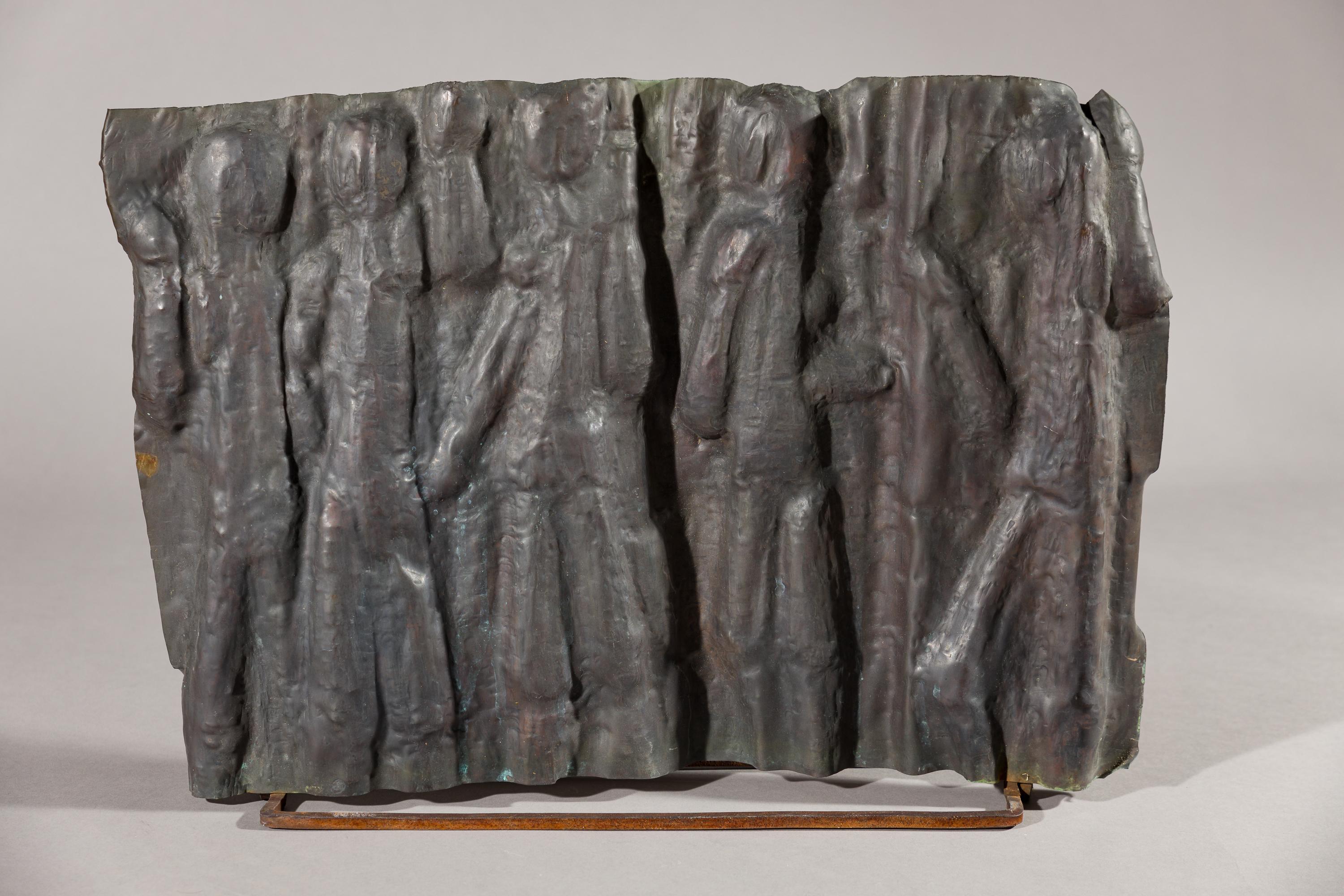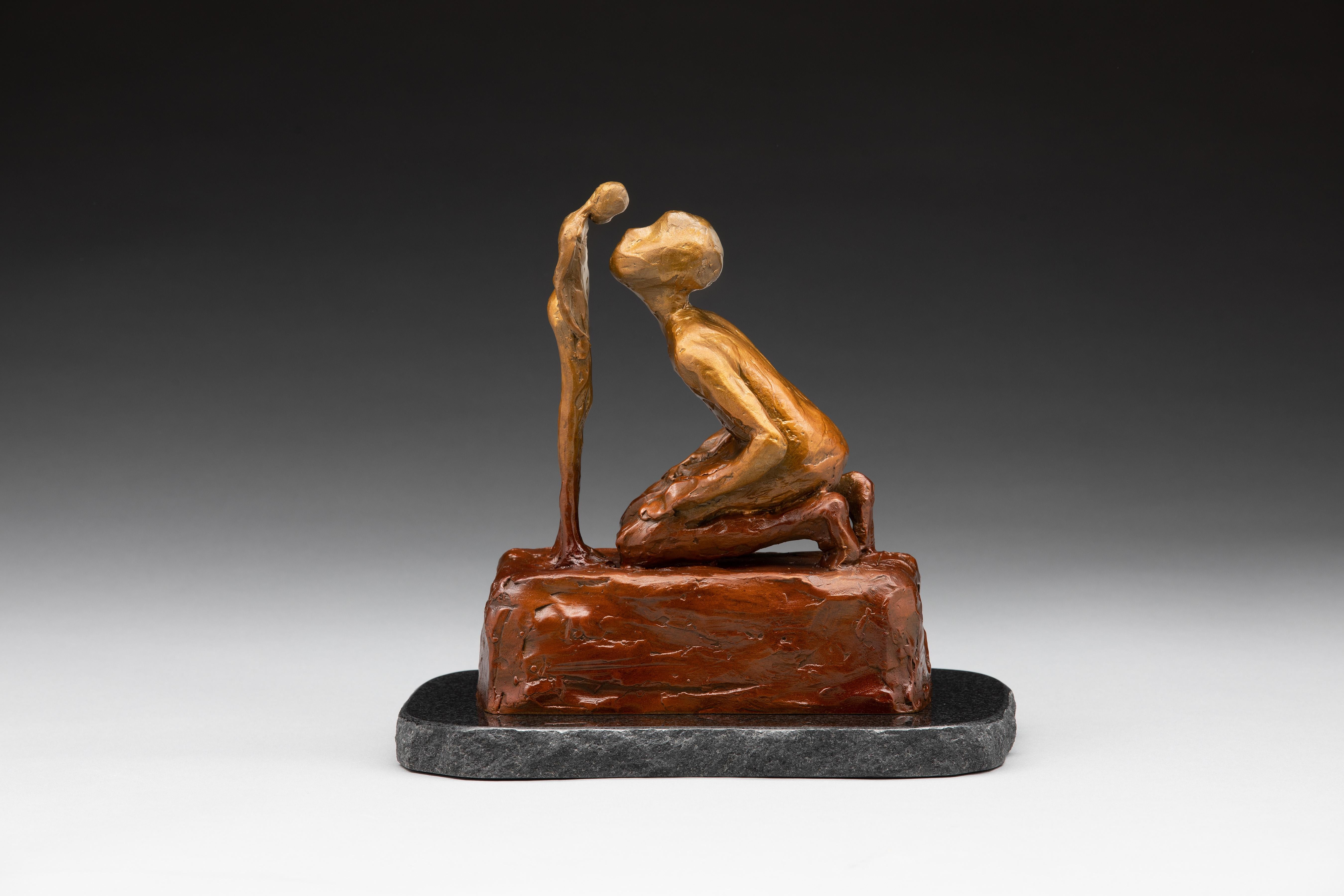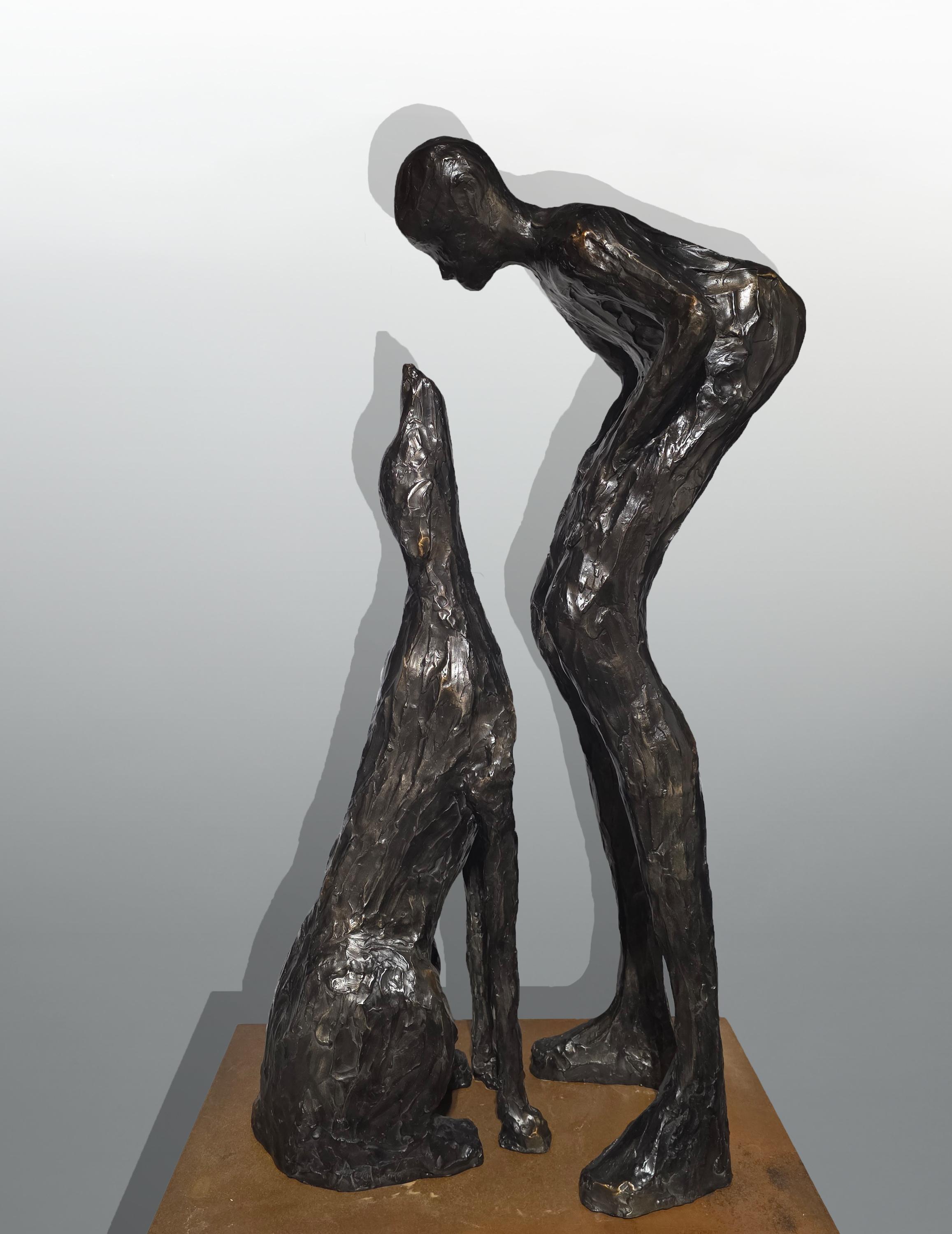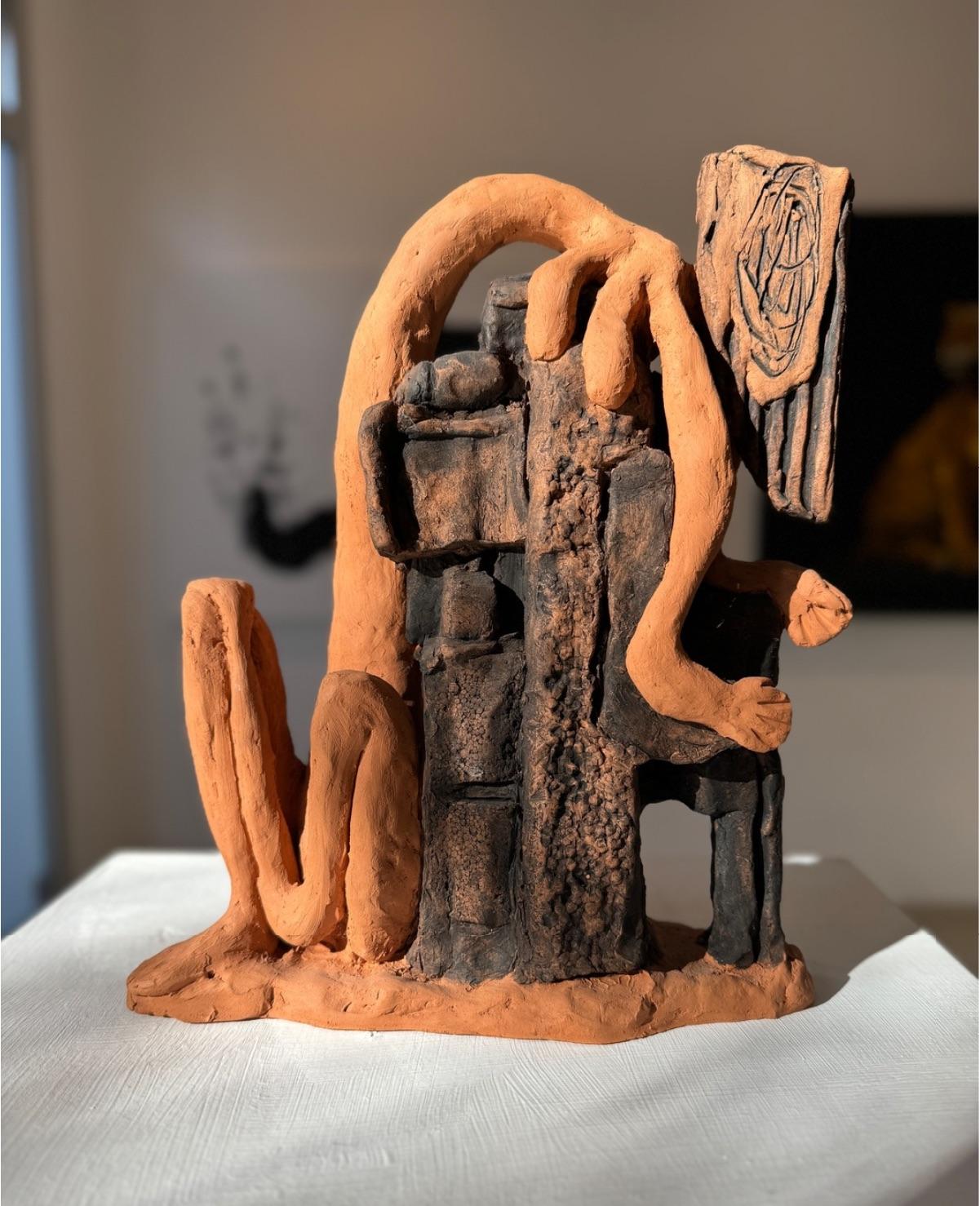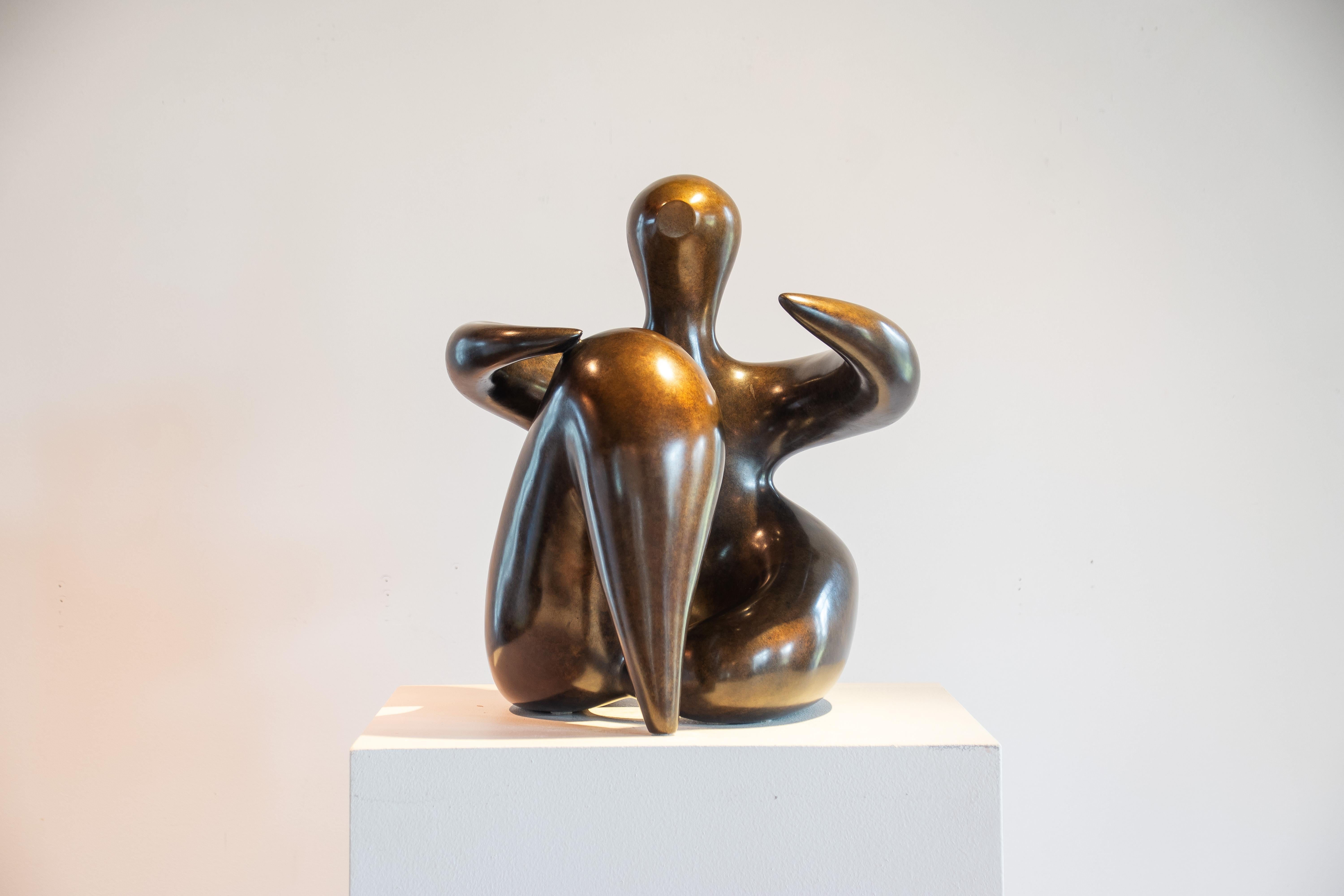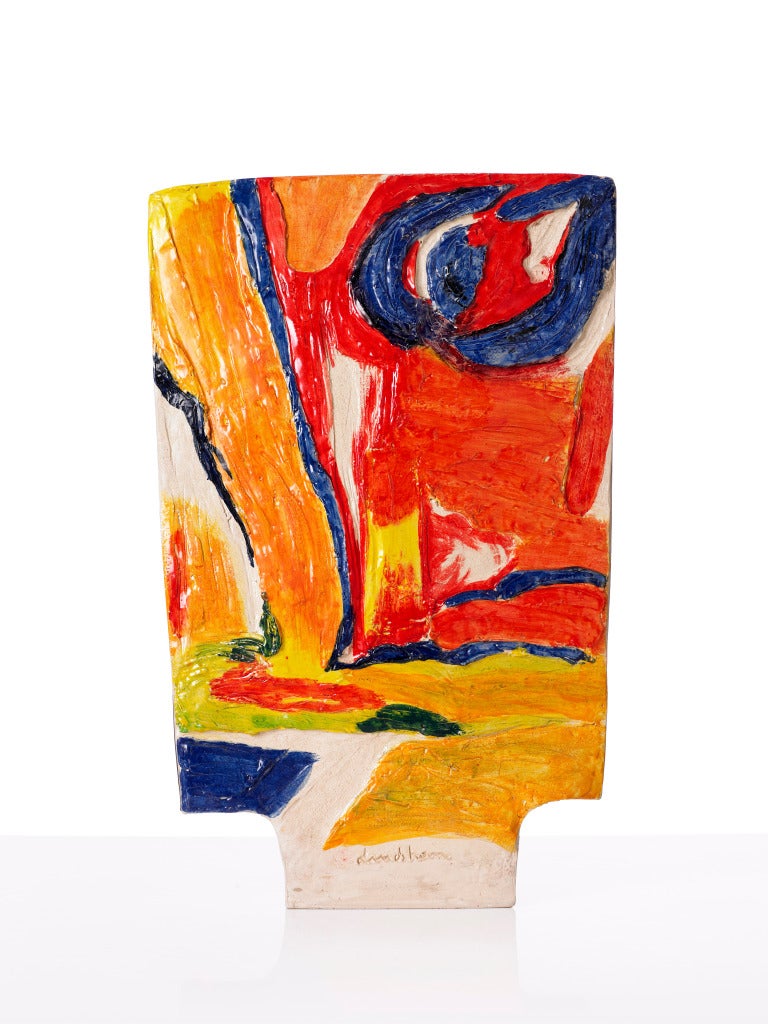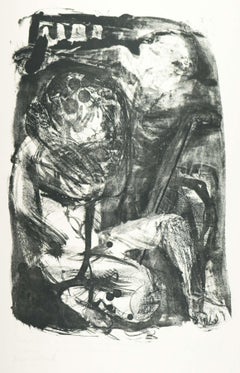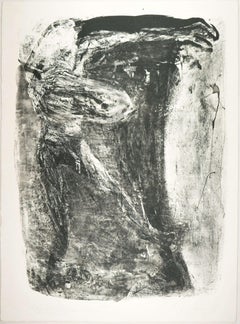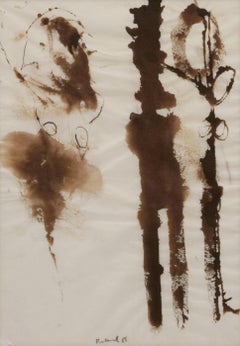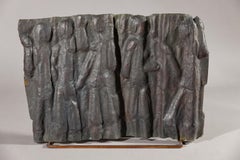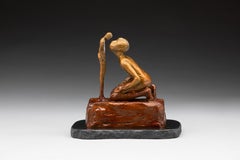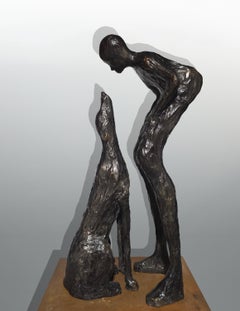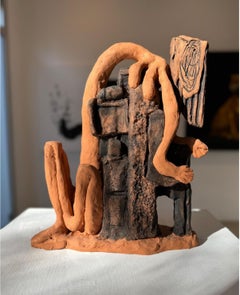Items Similar to Homage à Kahnweiler / - The Appearance of Genius-
Want more images or videos?
Request additional images or videos from the seller
1 of 6
Irmgard BiernathHomage à Kahnweiler / - The Appearance of Genius-1984
1984
$1,156.02
$1,445.0220% Off
£855.31
£1,069.1420% Off
€960
€1,20020% Off
CA$1,598.40
CA$1,99820% Off
A$1,754.85
A$2,193.5620% Off
CHF 915.51
CHF 1,144.3820% Off
MX$21,236.08
MX$26,545.1020% Off
NOK 11,474.46
NOK 14,343.0720% Off
SEK 10,811.96
SEK 13,514.9420% Off
DKK 7,309.47
DKK 9,136.8320% Off
About the Item
Irmgard Biernath (1905 Waldheim in Saxony - 1998 Mainz), Hommage à Kahnweiler, 1984. Terracotta relief, burnished red body, 43.5 x 38 cm, mounted on support plate, in wooden frame 57 x 49.5 cm, monogrammed "IB" at lower right.
- Isolated patina losses, but overall good condition, frame slightly bumped.
- The Appearance of Genius-
This homage to Daniel-Henry Kahnweiler shows the gallerist and art theorist as Pablo Picasso portrayed him in his lithographic portrait of 1957.
As an innovative Parisian gallery owner, Kahnweiler had exclusively represented Picasso since 1911, while Picasso had painted his famous portrait of Kahnweiler the previous year as a major work of Cubism. And it is Picasso who appears at the centre of Irmgard Biernath's image. Here, his face echoes the features of the self-portrait he painted in 1907 in the Prague National Gallery.
His eyes are wide open as he gazes into the distance, surrounded by the works of his artistic vision that have already taken shape. On the right is the bronze "Man with Sheep" from 1943, and on the left a flower representing Picasso's painterly work.
Kahnweiler, who was closely associated with Picasso's work, looks at the sculptures on the table in front of him with great attention and admiration. His head joins the sculptures and the flower to form a circle that surrounds Picasso's face like a wreath of honor, so the homage to Kahnweiler is first and foremost a homage to Picasso. As a sculptor inspired by Picasso's work, Irmgard Biernath herself follows in the footsteps of the artistic genius, whose face she makes appear on her relief as on the sweat shroud of Veronica.
About the artist
Irmgard Biernath worked as a teacher in Berlin from 1929. Because of her denunciation in 1941, she voluntarily resigned from teaching. After the Second World War, she followed her true calling as an artist and studied from 1946 at the Berlin-Weißensee School of Art with Bernhard Heiliger and from 1948 at the Nuremberg Academy of Fine Arts, where she was a master student of Hans Wimmer, among others. To earn a living, she taught art at the Anne Frank Realschule in Mainz from 1953 to 1971, for which she created a bust of Anne Frank. From 1958 to 1964 she was also a lecturer at the University Institute for Art and Work Education in Mainz. In addition, she was active at the Volkshochschule (adult education center), where she established the field of art education with her concept "Forming Hands" and left her mark for decades. From the 1960s on, Irmgard Biernath devoted herself more and more to her own work, working exclusively as a freelance artist since 1971.
Irmgard Biernath's artistic estate is housed in the museum of her hometown of Waldheim, where the Irmgard Biernath Foundation is also located.
Irmgard Biernath received numerous awards. Among others, she received the Federal Cross of Merit in 1976, the Rembrandt Medal in 1990, and the Mainz Plate, also in 1990.
Exhibitions
Kennen Sie ...? Biernath! Werke aus dem Nachlass der Bildhauerin Irmgard Biernath, Kulturzentrum Waldheim 2011.
Harmonie und Gleichgewicht im Werk der Irmgard Biernath, Stadt- und Museumshaus Waldheim, 2022.
Selected Bibliography
Irmgard Biernath (Hrsg.): Irmgard Biernath, Mainz 1990.
Marlene Hübel: Irmgard Biernath. Ein Lebenswerk, Mainz 1995.
Saur. Allgemeines Künstlerlexikon, Band 10, München - Leipzig 1995, S. 576-577.
GERMAN VERSION
Irmgard Biernath (1905 Waldheim in Sachsen - 1998 Mainz), Hommage à Kahnweiler, 1984. Terracotta-Relief, brünierter roter Scherben, 43,5 x 38 cm, auf Trägerplatte montiert, im Holzrahmen 57 x 49,5 cm, rechts unten mit „IB“ monogrammiert.
- Sehr vereinzelte Verluste der Patina, insgesamt aber wohlerhalten, Rahmen etwas bestoßen.
- Die Erscheinung des Genius -
Die Hommage an Daniel-Henry Kahnweiler zeigt den Galeristen und Kunsttheoretiker in der Art wie ihn Pablo Picasso in seinem lithographischen Porträt von 1957 dargestellt hat.
Als innovativer Pariser Galerist hatte Kahnweiler Picasso ab 1911 exklusiv vertreten, während Picasso im Jahr zuvor sein berühmtes Porträt Kahnweilers als ein Hauptwerk des Kubismus malte. Und Picasso ist es, der im Zentrum des Bildes von Irmgard Biernath erscheint. Dabei folgt sein Antlitz den Zügen des 1907 geschaffenen Selbstporträts der Prager Nationalgalerie.
Mit weit geöffneten Augen schaut er in die Ferne, während er bereits von den gestaltgewordenen Werken seiner künstlerischen Vision umgeben ist. Rechts neben ihm steht die Bronze „Mann mit Schaf“ aus dem Jahre 1943 und links ist eine Blume zu sehen, die für Picassos malerischen Werk einsteht.
Voller Aufmerksamkeit betrachtet der mit dem Werk Picassos eng verbundenen Kahnweiler die vor ihm auf dem Tisch situierten Skulpturen, zu denen er bewundernd aufblickt. Dabei verbindet sich sein Kopf mit den Skulpturen und der Blume zu einer Picassos Antlitz wie ein Ehrenkranz umgebenden Kreisform, weshalb die Hommage an Kahnweiler vor allem eine Hommage an Picasso ist. Als eine von Picassos Oeuvre inspirierte Bildhauerin tritt Irmgard Biernath selbst in die Fußstapfen des Künstlergenies, dessen Antlitz sie auf ihrem Relief wie auf dem Schweißtuch der Veronika zur Erscheinung bringt.
zur Künstlerin
Irmgard Biernath war ab 1929 Lehrerin in Berlin. Aufgrund ihrer Denunziation 1941 schied sie freiwillig aus dem Schuldienst aus. Nach dem Zweiten Weltkrieg folgte sie ihrer eigentlichen Berufung als Künstlerin und studierte ab 1946 an der Kunsthochschule Berlin-Weißensee bei Bernhard Heiliger und ab 1948 an der Akademie der Bildenden Künste Nürnberg, wo sie unter anderem Meisterschülerin bei Hans Wimmer war. Um den Brotererb zu sichern, war sie von 1953 bis 1971 Kunstlehrerin an der Mainzer Anne Frank Realschule, für die sie eine Büste der Anne Frank schuf. Von 1958 bis 1964 war sie auch Dozentin am Hochschulinstitut für Kunst- und Werkerziehung Mainz. Zudem war sie an der Volkshochschule tätig, wo sie den Bereich Kunsterziehung mit ihrem Konzept der „Formende Hände“ aufbaute und über Jahrzehnte hinweg prägte. Ab den 1960er Jahre widmetet sich Irmgard Biernath zusehend ihrem eigenen Schaffen, um dann ab 1971 ausschließlich als freischaffende Künstlerin tätig zu sein.
Der künstlerische Nachlass befindet sich im Museum ihrer Geburtsstadt Waldheim, wo auch die Irmgard-Biernath-Stiftung ansässig ist.
Irmgard Biernath wurden zahlreiche Ehrungen zuteil. So erhielt sie unter anderem 1976 das Bundesverdienstkreuz, 1990 die Rembrandt-Plakette und ebenfalls 1990 den Mainzer Teller.
Ausstellungen
Kennen Sie ...? Biernath! Werke aus dem Nachlass der Bildhauerin Irmgard Biernath, Kulturzentrum Waldheim 2011.
Harmonie und Gleichgewicht im Werk der Irmgard Biernath, Stadt- und Museumshaus Waldheim, 2022.
Auswahlbibliographie
Irmgard Biernath (Hrsg.): Irmgard Biernath, Mainz 1990.
Marlene Hübel: Irmgard Biernath. Ein Lebenswerk, Mainz 1995.
Saur. Allgemeines Künstlerlexikon, Band 10, München - Leipzig 1995, S. 576-577.
- Creator:Irmgard Biernath (1905 - 1998, German)
- Creation Year:1984
- Dimensions:Height: 17.33 in (44 cm)Width: 14.97 in (38 cm)Depth: 1.97 in (5 cm)
- Medium:
- Movement & Style:
- Period:
- Condition:
- Gallery Location:Berlin, DE
- Reference Number:1stDibs: LU2438213127682
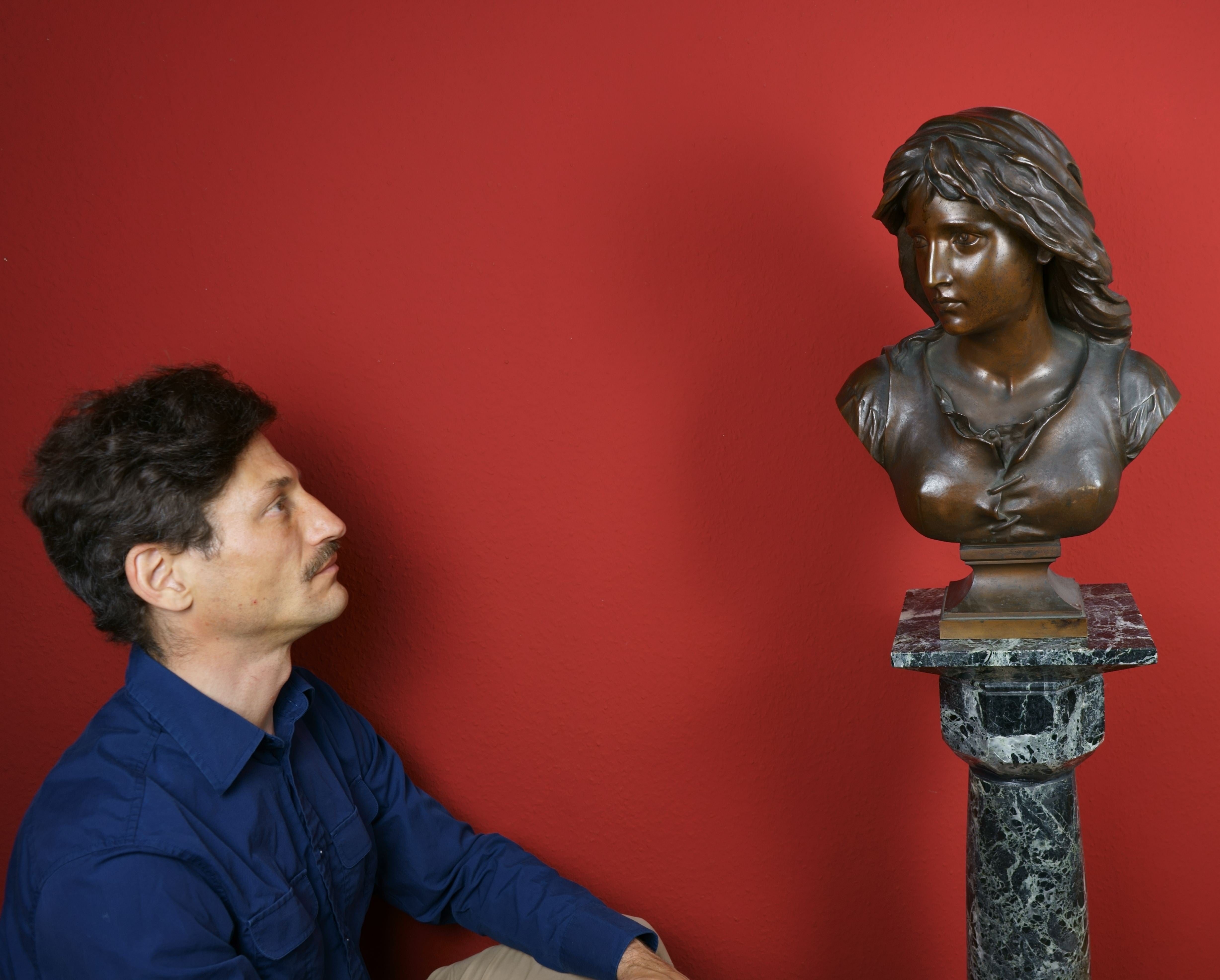
About the Seller
5.0
Vetted Professional Seller
Every seller passes strict standards for authenticity and reliability
Established in 2014
1stDibs seller since 2023
21 sales on 1stDibs
- ShippingRetrieving quote...Shipping from: Berlin, Germany
- Return Policy
Authenticity Guarantee
In the unlikely event there’s an issue with an item’s authenticity, contact us within 1 year for a full refund. DetailsMoney-Back Guarantee
If your item is not as described, is damaged in transit, or does not arrive, contact us within 7 days for a full refund. Details24-Hour Cancellation
You have a 24-hour grace period in which to reconsider your purchase, with no questions asked.Vetted Professional Sellers
Our world-class sellers must adhere to strict standards for service and quality, maintaining the integrity of our listings.Price-Match Guarantee
If you find that a seller listed the same item for a lower price elsewhere, we’ll match it.Trusted Global Delivery
Our best-in-class carrier network provides specialized shipping options worldwide, including custom delivery.More From This Seller
View AllRare Animal / - Abstract figuration -
Located in Berlin, DE
Veit Hofmann (*1944 Dresden), Rare Animal, 1987. Oil on light card, 42 cm (height) x 30 cm (width), monogrammed “V[eit]H[ofmann]” lower right and dated “[19]87”, titled “Seltenes Tie...
Category
1980s Abstract Expressionist Abstract Paintings
Materials
Oil
Threatening to defeat me once and for all / - A Christmas Pietà -
Located in Berlin, DE
Johannes Heisig (*1953 Leipzig), "Threatening to defeat me once and for all" - To the Christmas Oratorio by Johann Sebastian Bach. Lithograph on strong yellowish laid paper with wate...
Category
1980s Abstract Expressionist Figurative Prints
Materials
Lithograph
$366 Sale Price
20% Off
My treasure, my sanctuary / - A Tortured Treasure -
Located in Berlin, DE
Johannes Heisig (*1953 Leipzig), "My treasure, my sanctuary" - To the Christmas Oratorio by Johann Sebastian Bach. Lithograph on strong yellowish laid paper with watermark, 53 x 39.5...
Category
1980s Abstract Expressionist Figurative Prints
Materials
Lithograph
$366 Sale Price
20% Off
Untitled / - Association -
Located in Berlin, DE
Detlef Baltrock (*1954 Stuttgart), Untitled, 1985. Watercolor, 29.5 cm x 21 cm (visible dimensions), 41 cm x 32 cm (frame), signed “Baltrock” lower center and signed “[19]85”, label ...
Category
1980s Abstract Expressionist Abstract Drawings and Watercolors
Materials
Paper
Tectonic Tension / - Archetypes of Painting -
Located in Berlin, DE
Jürgen Möbius (*1939 Großenhain), Tectonic Tension. Oil on hardboard, 47.5 x 60 cm, 49 x 61.5 cm (frame), signed lower right "Möbius" and dated "[19]81".
- Upper left corner with a small chip, light scratches and a little rubbed in places. Provisional gallery frame with traces of use.
- Archetypes of Painting -
About the artwork
The form structure in front of the eye is overlapped by the frame. Thus, the frame does not open up a space in which something is presented, but rather shows the seemingly arbitrary section of a comprehensive context that cannot be framed as such.
We see forms that stand in a structure of tension with each other, whereby the individual black and brown forms, which continue almost endlessly beyond the frame, already show a tension in themselves, since they are not only forms, but also surfaces - form surfaces, while the light blue surface ground is at the same time forms that appear as surface forms. The formed surfaces and surface forms are nested within each other and form a structure that encompasses all elements.
The angular arrangement of the black and brown shaped surfaces gives the structure a tectonic character. The tension is thus heightened to the point of paradox, since the black shape at the front is overlapped by the brown shape at the bottom in the center of the picture, which would be impossible in real space. It is precisely through this "paradox" that Möbius demonstrates that the paradoxical is reality within painting. It is, so to speak, the most original possibility of painting, which distinguishes it from the other arts. In combination with the tectonic formations, Jürgen Möbius creates an archaic primordial painting, which, however, should not be confused with the autonomous color and form cosmos of Suprematism à la Kasimir Malevich. Instead of homogeneous, perfectly colored forms, here the colors are deliberately applied unevenly, and the light blue is mixed with the brown in a manner determined by the brushstroke. At the edges of the surface forms, the uneven application of paint allows the wood of the unprimed hardboard to show through. In this way, Möbius illustrates that we are dealing with a painting that has been created by an act of painting - an act, however, that takes hold of the original principles of painting and thus realizes painting as such.
About the artist
From 1959 to 1965 Jürgen Möbius studied painting at the University Institute for Art and Work Education in Mainz. He also studied philosophy and art history at the University of Mainz. Afterwards he worked as a freelance artist in Mainz.
At first, Möbius created material reliefs and installations, then, around 1974, he turned increasingly to conceptual art and added cinematic means. During this phase he wrote the manifesto-like essay "Principles of Supranatural Landscape" (1979).
From 1981 on, Möbius concentrated on painting and searched for artistic ways to "treat intellectual and sensual perception equally in the fusion of representational and abstract pictorial elements" (Wolfgang Zemter). He found inspiration on his study trips to Thailand and Sri Lanka.
"The pure painting of Jürgen Möbius flows through us as a timeless expression of memory and energy, ploughing our perception and bringing us the happiness of seeing authentic, immovable form.
- Philippe Büttner
Selection of solo exhibitions
1969 Galerie Würzner, Düsseldorf / Galerie Gurlitt, Mainz
1972 Städtische Galerie, Mainz
1973 Galerie Schloss Ringenberg Rathaus, Kleve
1974 Röderhausmuseum, Wuppertal
1976 Galerie Glasing, Osnabrück / Städtische Galerie, Herne
1977, 1997, 2004 Märkisches Museum, Witten
1979 Studio M, Bamberg / Staatstheater, Darmstadt
1980 Galerie Stolànovà, Wiesbaden / Mittelrheinmuseum, Koblenz
1982 Galerie Dornhöfer, Mainz
1984 Galerie Neumühle, Schlangenbad
1985 Landesmuseum, Mainz / Kunstverein, Ludwigshafen / Nassauischer Kunstverein, Wiesbaden
1986 Museum, Bochum / Galerie der Stadt Iserlohn
1987, 1990 Galerie Klaus Kiefer, Essen
1987, 2000 Galerie Ulrike Buschlinger, Wiesbaden
1988 Kunsthalle Darmstadt
1988, 1992, 1996, 1999 Galerie Leonhard, Basel
1992, 2002 Galerie Zulauf, Freisheim
1994 Galerie Remy, Vallendar
1995 Sendezentrum des Zweiten Deutschen Fernsehens, Mainz
2001 Collegium oecumenicum, Bamberg / MVB Forum für Kultur und Wirtschaft, Mainz
2006 Adam Gallery, London
Selection of group exhibitions
1969 ‘International Graphic Arts’, Galerie Dalléas Bordeaux, Paris
1975 ‘Deutscher Künstler-Bund’, Dortmund
1979 ‘Man and man’s Images’, Märkisches Museum Witten
1980 ‘Love-Dokuments of our Time’, Art Hall Darmstadt and Art Association Hannover
1982 ‘Work - Progress – Position’, Nassau Art Association Wiesbaden
1983 ‘Principle Hope – Utopic Aspects in Art and Culture of the 20th Century’, Museum Bochum
1986 ‘Selfportraits’, Gallery Klaus Kiefer Essen
1987 ‘The Dying and Death’, Gallery Klaus Kiefer Essen
1989 ‘Where are You, Revolution – Freedom, Liberty, Egality, Fraternity to-day’, Museum Bochum 1990 ‘Flight – a Problem within the Memory of Man’, Kunsthalle Darmstadt ‘Art and War 1939 – 89’, House of Cultures Berlin
1991 ‘Material and Form’, Pillnitz Castle Dresden and Pfalz Gallery Kaiserslautern
1995 20 Years Exhibitions, Chrämerhuus Langenthal, Schweiz
1998 ‘Works on Paper’, Klaus Kiefer Gallery Essen
2000 ‘Acquisitions 1900 – 2000’, Mittelrhein-Museum Koblenz
2001 ‘Strange Pictures’, Klaus Kiefer Gallery Essen
2002 ‘10 Years Buschlinger Gallery’, Buschlinger Gallery Wiesbaden
2004 ‘Eternal Space – Pictures and Sculptures’, Dome of Bamberg
2005 Art Fair Chicago, Adam Gallery, London
Selected Bibliography
Mittelrheinisches Landesmuseum (Hrsg.): Jürgen Möbius - Neue Bilder, Mainz 1985.
Kunstverein Darmstadt (Hrsg.): Jürgen Möbius. Bilder 1985 - 1988. Kunsthalle Darmstadt, 26. Juni - 14. August 1988. Red. Dorit Marhenke, Lyrik Marcus Schiltenwolf, Düsseldorf 1988.
Gabriele Prusko (Hrsg.): Jürgen Möbius. Mit Texten von Philippe Büttner und Ralph Mieritz, Basel 1992.
Wolfgang Zemter (Hrsg.): Jürgen Möbius - Aktuelle Arbeiten. Märkisches Museum der Stadt Witten, Bönen 1999.
Wolfgang Zemter (Hrsg.): Jürgen Möbius. Flieger in meinem Zimmer und Beruhigte Zone, Bönen 2004.
Dama Gallery...
Category
1980s Abstract Abstract Paintings
Materials
Oil
$1,348 Sale Price
20% Off
The Prophet / - The Burden of the Prophet -
Located in Berlin, DE
Wilhelm Gross (1883 Schlawe - 1974 Oranienburg-Eden), The Prophet, c. 1955. Woodcut on thin laid paper, 43 cm x 23 cm (depiction), 61 cm x 43 cm (sheet size), signed “Dr. Wilh.[elm] Gross” in pencil lower right, inscribed “Orig.[inal] Holzschnitt (Handabdruck)” lower left and inscribed “Aus der ”Ecce homo“ Folge” in the center.
- The wide margin with traces of pressing due to the impression, the sitter's left foot with a small purple stain, otherwise in vibrant condition.
- The Burden of the Prophet -
The large-format woodcut shows a prophet figure that takes up almost the entire height of the sheet. However, instead of seeing something in the distance that is still hidden from our eyes - as is usual in depictions of prophets - the figure has raised his hands in a defensive gesture, as if the prophet is trying to ward off what he has seen. At the same time, however, the position of the arms is an acceptance of the inevitable, which only those who recognize what is to come will have to bear for the time being, which is why the figure in the painting - despite its size - appears almost solitary, alone and exposed to the burden of suffering.
In a manner reminiscent of the folds of medieval wooden sculptures...
Category
1950s Realist Figurative Prints
Materials
Paper
You May Also Like
Ohne Titel / Untiteled
By Roland Goeschl
Located in Wien, 9
The present work is a rare piece from Roland Goeschl's time at the academy. In the technique of chased copper, which was unusual for him, forms are modelled that are still strongly r...
Category
1960s Contemporary Figurative Sculptures
Materials
Bronze
Good Enough 15/49
Located in Napa, CA
Lorri Acott is an internationally collected sculptor known for her impressionistic, figurative works that explore themes of connection, resilience, and the shared human experience. H...
Category
2010s Contemporary Figurative Sculptures
Materials
Bronze
5' Who Rescued Who ed/19
Located in Napa, CA
Lorri Acott is an internationally collected sculptor known for her impressionistic, figurative works that explore themes of connection, resilience, and the shared human experience. H...
Category
2010s Contemporary Figurative Sculptures
Materials
Steel
Angeli Minori A
Located in BARCELONA, ES
In apparent disagreement with the state of grace of human anatomy, Nicola Cucchiaro goes to the very origins of artistic endeavor. His production consists of combining and displacing...
Category
2010s Abstract Figurative Sculptures
Materials
Ceramic, Terracotta
Maria Martinez
By Cornelia Kubler Kavanagh
Located in Fairfield, CT
Cast bronze
Category
2010s Contemporary Figurative Sculptures
Materials
Bronze
Price Upon Request
L'esprit du feu
By Bengt Lindström
Located in Malmo, SE
Free shipment worldwide.
Edition of 12 ex.
Signed/Numbered.
Bengt Lindström was a big man from the central parts of the Norrland province, born in Storsjö Kapell on 3 September 1925...
Category
Early 2000s Contemporary Figurative Sculptures
Materials
Ceramic
